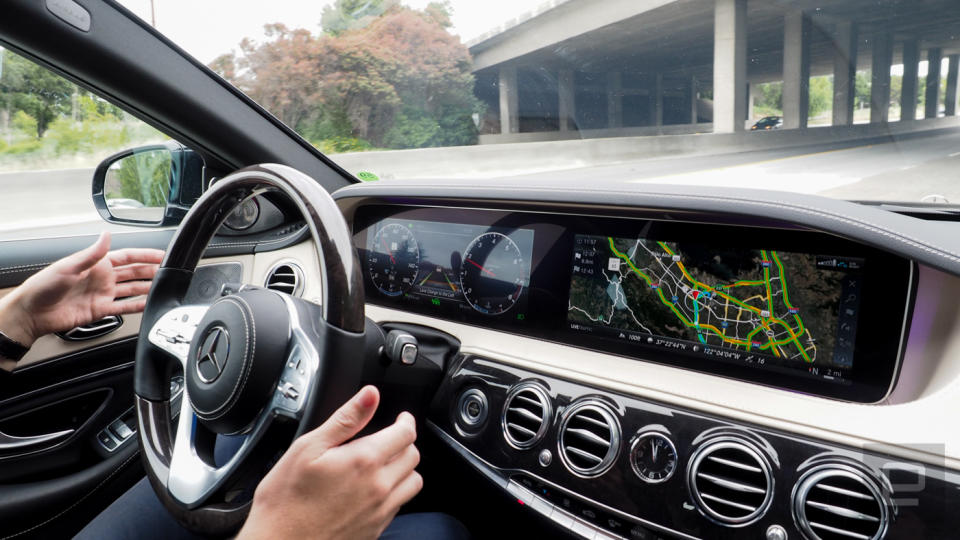Fragmentation in self-driving cars will eventually be a problem
Get ready for more partnerships.
If you remember the '80s, you were probably amazed that you could walk up to a computer, type the following in BASIC and something would happen:
10 PRINT "Robbie is rad"
20 GOTO 10
It seemed like magic at the time (which is good, because that's also the extent of my programming skills). That's sort of where the automotive AI world is in 2017. Artificial intelligence is on the cusp of bringing to life the sort of futuristic computer that can identify, parse and react to real-world driving scenarios.
But like everything in tech, it's in a hype cycle that's seeing dozens of companies, large and small, competing to make sure their technology is in the car of the future. This past year, I've have a non-stop parade of startups pitch me about their AI autonomous driving systems. Many of them are suspect, while a few, like AImotive and Comma AI, look like they're destined either to be swallowed up by a larger entity or to become part of the industry standard. But don't expect a lot to change in 2018.

"The autonomous vehicle industry is just getting started, and it's going to be decades and decades of development," said Danny Shapiro, NVIDIA's senior director of automotive. As the company building the hardware underpinning many current AI systems, NVIDIA has an insider's view. As Shapiro sees it, any standard for vehicle AI would just squelch innovation this early in the game.
Instead, for the next decade or so, you can expect to see consolidation. Automakers or large tech companies will gobble up smaller startups for their AI prowess or talent. It's a story that's played itself out over and over again in Silicon Valley. Over the past year Intel acquired MobileEye. GM (which had invested heavily in Lyft) invested heavily in Uber. Meanwhile Waymo is now teaming up with Lyft.
But the stakes are far higher for autonomous cars. They have the potential to save lives, expand transportation options for people who can't drive, and change the way cities and vehicles handle parking. And, of course, they will reduce CO2 emissions, by either being an EV or hybrid, or by driving more conservatively than humans.

But there needs to be a standard eventually. At some point, autonomous cars will be on the road and if there isn't a federally regulated standard governing how these vehicles interact with the world, there will be chaos as consumers, cities and automakers with competing systems follow slightly different rules. For example, if every vehicle treated an intersection differently, the resulting chaos would be no better than when humans are behind the wheel. Automakers understand this.
Although these companies are fundamentally using AI in the same way, there are some differences in how the data is parsed and what hardware is deployed in their automobiles. For example, Mercedes-Benz pulls information from LiDAR, hardware used to measure and map items in the real world with lasers. Instead of trying to crunch the individual pixels in the resulting images, it creates blocks of data it calls "Stixels." Meanwhile, Tesla doesn't believe it needs LiDAR data to teach or drive its cars.

BMW is working on its own AI tech now but sees a future in sharing. "We think that there will be an industry standard," said Peter Schwarzenbauer, the BMW AG board member responsible for digital business innovation. "But how it will turn out, we don't know yet. But I don't think that you'll see too many different systems on the planet." In addition to appeasing US regulators, car companies will have to adjust their AI systems for every region where they sell a car. It won't be easy, but if at some point they can reach an agreement, it will work to the benefit of all involved.
In 2018, expect to see more self-driving news out of Waymo, Mercedes, GM, Intel and other big tech and car companies. With nearly all the companies touting their method for training their AI systems in a simulation instead of on the road, expect more news about cloud-based driving tech. But there will also be many small players. Think: scrappy startups like AImotive and Comma AI that either rise to the occasion or collapse by overpromising and under delivering. But mostly be on the lookout for more partnerships like the one between GM and Lyft (and now Uber).
2017 was all about the AI hype. In 2018, companies are going to have to start delivering on their promises to make self-driving cars a reality. Because, eventually, our lives will depend on it.
Check out all of Engadget's year-in-review coverage right here.
Correction: An earlier version of this article indicated that Ford and Intel have a partnership in the automotive space. They do not. Intel just uses Ford vehicles for its tests.














